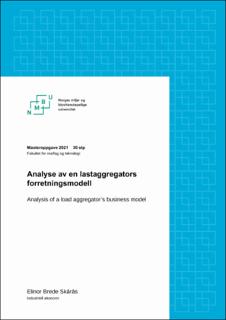| dc.contributor.advisor | Stevik, Tor Kristian | |
| dc.contributor.author | Skårås, Elinor Brede | |
| dc.date.accessioned | 2022-05-06T13:03:43Z | |
| dc.date.available | 2022-05-06T13:03:43Z | |
| dc.date.issued | 2021 | |
| dc.identifier.uri | https://hdl.handle.net/11250/2994613 | |
| dc.description.abstract | Kraftsystemet gjennomgår store endringer som følger av blant annet utfasing av fossil kraft, elektrifisering og en økende andel ikke-regulerbar fornybar kraftproduksjon. Endringene forventes å føre til mindre tilgjengelig kraftproduksjon i perioder, høyere effekttopper og økt kraftetterspørsel. Det er derfor et økende behov for økt forbrukerfleksibilitet for å balansere produksjon og etterspørsel i systemet.
Denne oppgaven undersøker lønnsomheten til en lastaggregator som driver med fjernstyrt lastkontroll av elektriske varmtvannsberedere til husholdninger, gitt en rekke avgrensninger, med mål om økt utnyttelse av forbrukerfleksibilitet. I analysen undersøkes lønnsomheten til en lastaggregator med to ulike strategier; termisk lagring og rask respons. For å svare på forskningsspørsmålene utføres det en analyse, som inkluderer både en kvalitativ og kvantitativ del, samt en Monte Carlo-simulering. For simulerte verdier benyttes nettonåverdimetoden for å undersøke lønnsomheten over en lengre analyseperiode. Resultatet viser ikke et helhetlig bilde av lønnsomheten til forretningsmodellen på grunn av avgrensningene. Videre er det blitt gjort flere forutsetninger og antagelser som har påvirket resultatet.
For strategien rask respons viser resultatet at aggregator er avhengig av å ha tilstrekkelig lastvolum tilgjengelig for laststyring for å kunne delta i balansemarkedet. Videre er aggregator avhengig av å få tilslag på bud for å generere inntekt. For strategien termisk lagring viser resultatet at det er redusert kraftkostnad som utgjør størst andel av den totale besparelsen ved laststyring. Aggregator er avhengig av å koble ut forbruk ved høye kraftpriser i markedet, og besparelsen kan øke med høyere prisdifferanse mellom utkoblingstidspunkter og perioden payback-effekten oppstår. Besparelsen vil også kunne øke med høyere lastvolum tilgjengelig for laststyring.
Resultatet viser videre at det er stor usikkerhet knyttet til forretningsmodellens lønnsomhet, og at lønnsomheten kan styrkes av en rekke forhold. Dette inkluderer reduserte kostnader gjennom lavere kompensasjon til sluttbrukere og lavere teknologikostnader. Videre kan lønnsomheten styrkes med økte inntekter gjennom blant annet utvidelse av kundesegmentet og/eller økt tilgjengelig lastmengde, endret kompensasjonsmekanisme, utvikling i kraftpriser (for strategien termisk lagring) og regulatoriske endringer (for strategien rask respons). | en_US |
| dc.description.abstract | The power system is undergoing major changes as result of several drivers, including the phasing out of fossil power, electrification, and an increasing share of variable renewable power production. The changes are expected to lead to less available power production in periods, higher power peaks and increased power demand. Therefore, there is an increasing need for demand response to balance production and demand in the system.
This thesis examines the profitability of a load aggregator that operates with remote load control of electric storage water heaters for households, given several limitations, with the goal of increased utilisation of demand response. The analysis examines the profitability of a load aggregator with two different strategies; thermal storage and fast response. To answer the research questions, an analysis is performed, which includes both a qualitative and quantitative part as well as a Monte Carlo simulation. For simulated values, the net present value method is used to examine the profitability over a longer analysis period. The result does not show a comprehensive picture of the profitability of the business model due to the delimitations. Furthermore, several assumptions and preconditions have been made, which have affected the result.
For the fast response strategy, the result shows that the aggregator is dependent on having sufficient load volume for load control to be able to participate in the balancing market. Furthermore, the aggregator is dependent on getting accepted bids to generate income. For the thermal storage strategy, the result shows that reduced power costs represent the largest proportion of the total savings by load control. The aggregator is dependent on disconnecting consumption at high power prices in the market, and the savings increase with a higher price difference between switch-off times and the period in which the payback effect occurs. The savings will also increase with higher load volumes available for load control.
The results further show that there is great uncertainty associated with the business model’s profitability, and that the profitability can be strengthened by several factors. This includes reduced costs through lower compensation to end-users and lower technology costs. The profitability can also be strengthened with increased revenues through for instance, expansion of the customer segment and/or increased available load volume, changed compensation mechanism, development in power prices (for the thermal storage strategy) and regulatory changes (for the fast response strategy). | en_US |
| dc.language.iso | nob | en_US |
| dc.publisher | Norwegian University of Life Sciences, Ås | en_US |
| dc.rights | Attribution-NonCommercial-NoDerivatives 4.0 Internasjonal | * |
| dc.rights | Attribution-NonCommercial-NoDerivatives 4.0 Internasjonal | * |
| dc.rights | Attribution-NonCommercial-NoDerivatives 4.0 Internasjonal | * |
| dc.rights.uri | http://creativecommons.org/licenses/by-nc-nd/4.0/deed.no | * |
| dc.title | Analyse av en lastaggregators forretningsmodell | en_US |
| dc.title.alternative | Analysis of a load aggregator’s business model | en_US |
| dc.type | Master thesis | en_US |
| dc.description.localcode | M-IØ | en_US |

